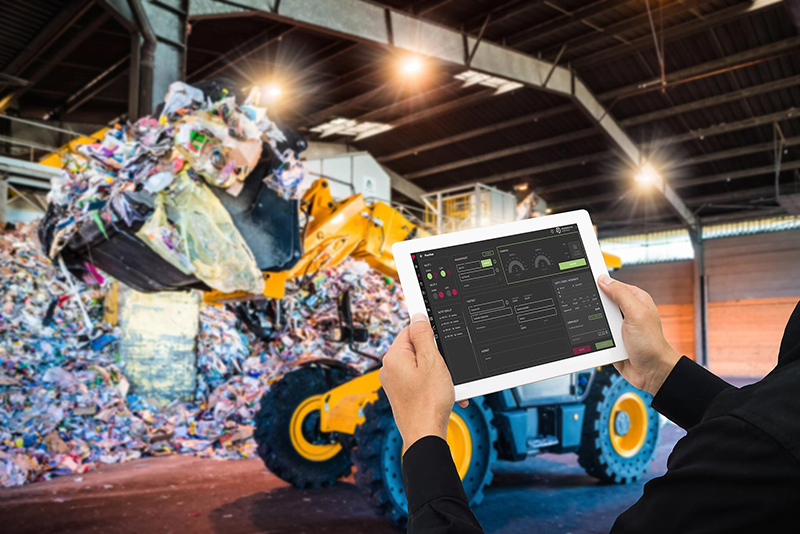
The efficient management of material flows is in key role in maintaining and improving the profitability of businesses operating in circular economy. These businesses often manage up to hundreds of inbound and outbound material flows in various different systems, such as Excel and in some cases traditional paper documents like movement documents. This unavoidably means that dozens of working hours and thousands of euros are spent on manual work, data transfer and problem solving every month.
So what should be taken into account in the management of material flows? How can different parts of the supply chain become smoother and what is the role of digitalization in making operations more efficient? Below, I have compiled some of my observations on the critical stages of the supply chains of material flows that are full of unrealized potential to make operations more efficient and improve profitability.
1. Smart reception of materials
In regards to the reception of materials, it is important that the facility receiving the material can get real-time data from the delivery organization. This is the stage in which information on the origin and supplier of the materials as well as invoice receiver and amount are transferred into the receiver’s systems.
Receiving materials is most efficient if the receiving facility has a digital material management and reporting system in use. Flow by Pinja can be directly integrated into the receiver’s weighing systems, and the weight data is automatically forwarded in the system all the way to invoicing. The fewer manual work phases are included in the supply chain - such as twiddling with Excel or filling paper forms - the better we can minimize human errors and improve the cost efficiency and agility of the whole supply chain.
2. Real-time storage management
Often storage management is based on approximate estimates and regular inventories that take a lot of time and don’t allow you to monitor data in real time. However, real-time data plays a huge role in reporting and the methodical improvement of business. When up-to-date information on the sale and processing of materials is available, operations can be better planned out and managed in the long-term and predictively.
Storage management is also connected to authority regulations. A digital storage management system decreases the amount of work spent in reporting and maintaining the storage balance sheet since all data can be found in one digital folder. It is also easy to automate reports directly from the system to support in-house decision-making and to inform outside stakeholders. Digital storage management also allows you to trace the origin of the processed materials which is important especially when processing recycled materials.
3. Automatic data transfer between systems
When you’re using multiple different systems, calculation sheets and files, data transfer between systems takes a lot of valuable time and the risk of entering wrong information increases. The risk also increases through centralizing the task to just a few people; in this case, only a few people in the company know how to use different systems or Excel. It's a big difference compared to making data available to all parties of the supply chain in real time and in one easy-to-use system.
Overlapping systems also mean that all new data on e.g. new customers or material flows has to be added into multiple different systems. Let alone having to manage all this - material, customer, contract and invoicing data - in various different systems at the same time.
For example, the system can submit pre-filled data to the delivery driver during the weighing and receiving of the materials. The system can offer each driver the options that are relevant to their delivery company. The driver’s only responsibility is to check that all information is correct and to collect required signatures instead of having to pick the right information among dozens or even hundreds of options.
This makes the whole weighing process faster and minimizes the risk of errors. The process is agile from start to finish through mobile, and data is forwarded to the receiver’s system in real time.
4. Sharing information between all parties in the supply chain
If you don’t have a digital management system of material flows in place, sharing information between the different parties in the supply chain might cause a lot of extra work. Since you have to wait for information from different parties at different stages of the transaction, the invoicing periods also become longer; whereas in an ideal case, information on a delivery could be transferred directly from weighing to the storage management system and to the invoicing system. A digital management system of material flows allows all parties to have a mutual portal where real-time data is easily available for all partners.
Real-time data sharing also minimizes the amount of errors and complaints as everyone can see the same real-time data through the cloud service. This directly decreases the amount of manual work needed in invoicing. Instead of taking care of boring tasks like managing complaints, you can direct your energy into more productive activities. At the same time, you will be able to serve your customers better as you can submit data on materials received from them regarding their quality, processing, level of recycling or even CO2 emissions.
As legislation and reporting requirements become stricter, real-time data transfer also makes it possible to trace the origin of materials better. These days customers are also increasingly more interested in the origin of recycled materials and the processing methods of side flows; this means they must be transparently traceable for every material flow. If the different stages of the supply chain are reported on different calculation sheets, invoices and paper documents, monitoring becomes increasingly complex.
+1 Visible material flows are easy to invoice
One of the most important benefits of a digital material flow management system for operators in the circular economy is the efficient and precise data collection. When data is collected and analyzed in real time in every part of the supply chain, material flows will be converted into profits more easily. The system helps you invoice the correct clients for the correct items and at the correct prices. All materials that can be invoiced will show as visible profit on the data sheet. Companies that are making their business more efficient through digitalization will be the ones to succeed in this changing world and fierce competition.
Read more
Flow by Pinja
Digitalization supports the profitability of circular economy businesses
Guide: 6 tips for streamlining inbound and outbound operations
Back to the Pinja Blog
Categories
- Career at Pinja (68)
- Manufacturing (48)
- Knowledge Management (45)
- Production Development (44)
- Software Partnership & Tools (42)
- Sustainability (37)
- Wood and Forestry (37)
- Bioenergy and Recycling (27)
- IT Support and Outsourcing (24)
- Ecommerce (23)
- Maintenance (22)
- Artificial Intelligence and Machine Learning (15)
- Public Services (9)
- Compliance (1)
